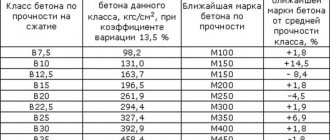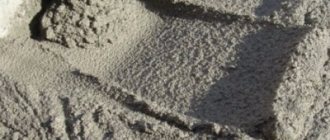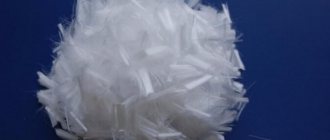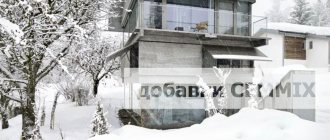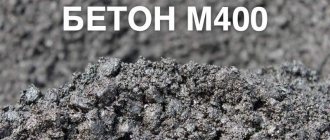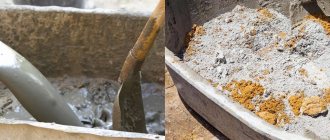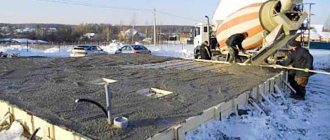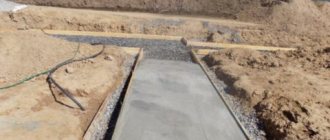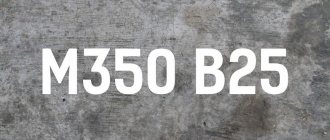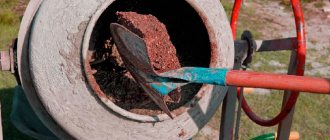Moisture-resistant reinforced concrete is a special type of material in which there are no pores and capillaries (voids) that allow the bulk of moisture to pass through. The material is characterized by increased density , which determines its specific properties, but this is not enough to ensure complete waterproofing.
Water resistance classes
The grade of concrete related to the degree of waterproofness is indicated by the letter “W” followed by a numerical value. The number can range from 2 to 20 and determines the maximum permissible fluid pressure.
Concrete with maximum water resistance is labeled W20 and vice versa. In private housing construction, it is enough to use material W4-W8 , but if groundwater is close, this figure can be increased to W12.
Porosity of concrete
No matter how carefully the concrete solution is mixed, when it is poured, pores will always remain in the body of the structure. And the more there are, the lower the strength of concrete. Therefore, after pouring it must be compacted. But the pores still remain, albeit in small quantities. These pores are the worst enemy of a concrete structure.
The thing is that water, getting into these pores, freezes in winter, expanding in volume (up to 9%). In this case, high pressure begins to act on the pore walls, which leads to the formation of cracks. At first these are mini-cracks, which grow from year to year into large cracks.
Properties of waterproofing additives
Attention. Waterproofing additives do not eliminate pores and cracks in a concrete structure. They create a water-repellent barrier.
This barrier prevents water from penetrating into the material. With such additives, concrete has the highest level of water resistance.
With this method, shrinkage should be minimal. To achieve this, builders do the following:
- Moisten fresh concrete every three hours for the first three days;
- Cover the area filled with concrete with damp burlap;
- They use a special product that forms a film.
Waterproof concrete - what is it?
Waterproof concrete is a special type of mixture in which there are no different types of voids (capillaries, pores) through which moisture can enter the structure of the monolith. The density level of such material significantly exceeds standard values. In addition, the monolith is protected by external means, sealing the seams.
But achieving the highest level of waterproofing is possible only in monolithic structures - if the prefabricated structure has many moving seams, it cannot demonstrate waterproof characteristics.
The main reasons for the appearance of water in concrete:
- The presence of pores that appear due to the large volume of water added to the solution
- Presence of defects due to incorrect or insufficient compaction of the poured mixture
- Various types of deformations leading to the spread of cracks throughout the stone
You can increase the water resistance of the compositions in two ways - by selecting the correct ratio and type of components, or by introducing special additives into the solution, which make it possible to obtain a denser stone without pores and capillaries, due to which the material becomes as resistant to water as possible (it simply does not absorb or let it through) .
DIY waterproof concrete
First you need to decide what kind of concrete you need: waterproof or frost-resistant.
Where is waterproof concrete needed?
If you want to make sure that water can't get through the concrete you use, then you need waterproof concrete.
For example, waterproof concrete is needed if you decide to pour:
- foundation slab or other concrete foundation structures that are not subject to water filtration;
- concrete floor, walls of the basement, cellar, garage, insulating from ground moisture;
- walls and bottom of the cesspool that prevent sewage from entering groundwater;
- water-tight walls and bottom of a decorative pond, water conduit;
- waterproof screed on the roof of an underground garage, basement.
Where is frost-resistant concrete needed?
Frost-resistant concrete is needed if you want to be sure that moistened concrete, when the temperature drops to negative (especially after numerous cycles of transition through zero temperature in the off-season), will not be destroyed by freezing water after exposure to rain and other precipitation, groundwater, high water, melt water and flood. So that neither the ice inside the concrete nor the frost outside provokes its destruction. For example, if you decide to make:
- concrete path or blind area, paving slabs;
- a wall above the ground in contact with the blind area;
- concrete enclosing structures (fence, walls, fences, curbs);
- concrete decorative elements (pedestals, figures, decorative items imitating natural stone);
- concrete load-bearing structures (columns).
Choosing material
| Additive for producing waterproof concrete (frost resistance as an additional effect) | Additive for obtaining frost-resistant concrete (water resistance as an additional effect) |
| Dehydrol lux brand 10-2 “Liquid waterproofing hyperconcentrate” | Betonoprav luxury brand 2 “Liquid additive for producing corrosion-resistant concrete” |
We make waterproof and frost-resistant concrete with our own hands
| Waterproofing materials Dehydrol and concrete additives Betonoprav allow you to reliably produce hydraulic concrete not only at stationary concrete mortar units, but also independently, using a conventional concrete mixer |
How to make hydraulic concrete with your own hands
First you need to decide what kind of concrete you need: waterproof or frost-resistant.
Where is waterproof concrete needed?
If you want to make sure that water can't get through the concrete you use, then you need waterproof concrete.
For example, waterproof concrete is needed if you decide to pour:
Where is frost-resistant concrete needed?
Frost-resistant concrete is needed if you want to be sure that moistened concrete, when the temperature drops to negative (especially after numerous cycles of transition through zero temperature in the off-season), will not be destroyed by freezing water after exposure to rain and other precipitation, groundwater, high water, melt water and flood. So that neither the ice inside the concrete nor the frost outside provokes its destruction. For example, if you decide to make:
Choosing material
| Additive for producing waterproof concrete (frost resistance as an additional effect) | Additive for obtaining frost-resistant concrete (water resistance as an additional effect) |
| Dehydrol lux brand 10-2 “Liquid waterproofing hyperconcentrate” | Betonoprav luxury brand 2 “Liquid additive for producing corrosion-resistant concrete” |
We make waterproof and frost-resistant concrete with our own hands
| Waterproofing materials Dehydrol and concrete additives Betonoprav allow you to reliably produce hydraulic concrete not only at stationary concrete mortar units, but also independently, using a conventional concrete mixer |
Making hydraulic (waterproof) concrete with the waterproofing additive Dehydrol Lux grade 10-2 with your own hands:
Concrete mix recipe and dosage of additives
The dosage of both additives is the same and, as a rule, is 4 liters per 1 m 3 of concrete. Accordingly, for a concrete mixer in which 100 liters of concrete are mixed at a time (i.e. approximately 200-240 kg), you will need only 0.4 liters of Dehydrol or Betonoprava.
Approximate recipe for waterproof concrete:
| Cement | Sand | Crushed stone | Dehydrol luxury brand 10-2 | Water |
| 50 kg | 60 kg | 110 kg | 0.4 l | 19-20 l (no more) |
| 50 kg | 60 kg | 120 kg | 0.5 l | 17 l |
Approximate recipe for frost-resistant concrete:
| Cement | Sand | Crushed stone | Concrete setter luxury brand 2 | Water |
| 50 kg | 60 kg | 110 kg | 0.4 l | 19-20 l (no more) |
| 50 kg | 60 kg | 120 kg | 0.5 l | 17 l |
To immediately select the plasticity of the concrete mixture you require, you should first pour water into the concrete mixer, then the additive, and then gradually add cement, sand and crushed stone in the required proportions. After 5 minutes of mixing, the concrete mixture for hydraulic concrete is ready.
Remember:
When concrete is poured, remember about maintenance and waterproofing of joints!
Source
Coating option
To waterproof concrete surfaces, they are coated with special waterproofing compounds that penetrate into the thickness of the concrete and clog the pores.
Waterproof concrete can be obtained by applying coating materials to its surface. They can be used as hot mixtures based on bitumen and mastic. To do this, it is important to prepare the concrete surface for processing. She is being cleansed. Then 2 layers of primer are applied. The first includes a slow-acting solvent, the second - a fast-acting one. These layers contribute to better adhesion of the coating solution and the concrete surface. The coating material is applied in two layers. First one, then the second. Within a few minutes you can observe how a special protective film forms on the concrete.
This method is better than painting, as it is more durable. But it also has a number of disadvantages. The most important of them is that even with slight deformation of the concrete and its surface, the coating can collapse. In addition, there are often cases of coating dripping. The reason for this is the incorrect selection of mastic. It is very important to know that the coating is applied in 2 layers, each about 2 mm thick. After applying the feather coat, you need to carefully check the quality of the coating and only then continue working.
Characteristics of concrete grades for water resistance
The market offers a huge selection of building materials. And it is not always possible for an ordinary consumer to determine the brand he needs. Therefore, you should familiarize yourself with the possible labeling and use of these brands of mixtures in practice. There is a table corresponding to the strength class of concrete and its brand. According to GOST, there are requirements for brands that are necessary to achieve the desired result. The most commonly used grades of concrete are waterproof grades no lower than W6. Every brand has limitations. It is thanks to the brands that you can understand what water pressure a concrete solution can withstand. Indicators that determine the interaction of concrete with water are identified. This:
- straight (the level of water resistance that corresponds to the brand, and the coefficient of possible filtration);
- indirect (the ratio of water and cement, its absorption in accordance with mass).
In everyday life, attention is often paid to the first indicator - the water resistance of concrete; it is considered indicative. The remaining three components are used less frequently, and then only in the process of producing the mixture or in scientific experiments. Each grade characterizes the degree of interaction of moisture with concrete, which can be either less or more. The main brands are considered to be:
- W4. She has a normal degree of permeability. This means that the absorbed level of moisture is within normal limits, but use for buildings with a good level of waterproofing is not suitable.
- W6. Moisture permeability is reduced. Unlike the previous one, it is of average quality, more moisture-proof, and is used most often in construction work.
- W8. Mixture with low water resistance. Permits moisture in small quantities. The mixture turns out more expensive than the previous one.
Brands that go further down the line become more hydrophobic. The most resistant to moisture is the W20 mixture, but it is rarely used due to its high price. Therefore, W10-W20 is used for the construction of reservoirs, bunkers or hydraulic structures. They have one more, rather positive, quality - frost resistance. It is important to be able to select the class of concrete and its purpose. So, in order to fill the foundation, it is necessary to make W8, and at the same time make additional waterproofing. You can plaster walls in a room with normal humidity using W8-W14. When the room is cold and damp, it is better to use higher grades, while doing additional treatment with a special primer. When finishing the external walls of a house, it is necessary to use higher grades to ensure the best level of water resistance. This is important because there will be constant changes in the environment and dampness should not enter the house.
First you need to decide what kind of concrete you need: waterproof or frost-resistant.
What brand of concrete is used?
To carry out critical work (excluding laying a house blind area), concrete grades M300-M450 are used. The best option, based on technical and operational characteristics and cost, is M400.
- Water resistance – W8;
- Relative density – 2400-2700 kilograms per cubic meter;
- Compressive strength – class B30;
- Plasticity and rigidity – P3, G3;
- Frost resistance – up to 300 complete freezing and thawing cycles;
- Cone shrinkage is 4-7 centimeters without the use of additives in the form of expanders.
Absolute proportional composition:
- 1 part of cement grade M500;
- 1.6 parts sand;
- 3.2 parts crushed stone.
Mass values of M400 concrete components per 1 cubic meter of finished mixture:
- 390-410 kilograms of cement;
- 150-170 liters of water;
- 640-660 kilograms of sand;
- 690-710 kilograms of crushed stone of a fraction of 20 millimeters;
- 450-460 kilograms of crushed stone of a fraction of 10 millimeters;
- 3-7 kilograms of additives.
Waterproof concrete
1.1. Features of waterproof concrete
The job of waterproof concrete is to:
- or “repel” water (not get wet), which is ensured by the use of water repellents:
Photo 1. Operation of water repellent
- or do not let water inside, but if there is no water pressure (as with spraying or other slight moistening), which is ensured by partial overgrowth of capillaries by using clogging materials in minimal dosages, or better yet, specially developed materials for partial clogging (such as Kontacid grade 3 ):
Photo 2. Work of Contacida brand 3
In this case, the porosity of concrete either practically does not change (in the case of hydrophobization) or decreases slightly (in the case of partial clogging), so water under pressure can penetrate through such concrete. For example, according to A.A. Alentyeva et al. “Organosilicon hydrophobizers”, the critical pressure that hydrophobized bodies can withstand (edge wetting angle 140°), depending on the pore diameter, is:
Hence the main use of waterproof (and especially hydrophobized) concrete is above the water level (i.e. protection from dampness and corrosion):
- walls in the above-ground part of the structure on the windward side;
- concrete floor in workshops, warehouses, not in contact with groundwater.
1.2. Obtaining waterproof concrete
You can get waterproof concrete:
- from a concrete mixture , for example, by introducing into it a water repellent or a bridging additive (optimized in quantity and formulation - such as Kontacid grade 3 (for highly porous concrete) or Betonoprav luxury grade 2 (for low-porosity concrete));
- or by treating the existing concrete with a water repellent or bridging impregnation (optimized in quantity and formulation - such as Contacid grade 3 solution).
However, when using a water repellent, you should remember its features. Any water repellent, due to its water-repellent properties (i.e. the target effect - see photo 1), is a material that prevents:
- penetration of aqueous solutions into the substrate, incl. clogging pores;
- wetting the substrate and adhesion of water-containing solutions to it, incl. solutions based on cement, lime, gypsum, as well as water-based paints and varnishes.
Accordingly, with effective hydrophobization, you may subsequently encounter problems associated with the impossibility of high-quality:
- repair and consolidation of the substrate;
- decorative processing of the substrate.
Taking into account these features of water repellents, the creation of water-resistant concrete using a system of compatible materials Dehydrol, Betonoprav, Kontatsid is based on partial clogging (see photo 2).
Production of waterproof concrete using the Dehydrol, Betonoprav, Kontacid system
For the production of homogeneous, highly water-resistant concrete, incl. on porous aggregates, you can use the optimized additive Betonoprav lux grade 2 in an amount of 3-4 liters per cubic meter of concrete mixture. This additive also gives concrete corrosion resistance (frost resistance) and further increases its water resistance.
Do-it-yourself composition and production of waterproof concrete
The effect of moisture resistance of concrete can be achieved using special substances. There are several types of composition:
Portland cement (PC)
This is a hydraulically binding substance, which includes calcium silicate “Alita”, additives (clinker, gypsum, minerals). The building material is made in accordance with GOST 10178.85 and 31108.2003. PC brands: M400, M500, M600.
Pozzolanic
It has the property of hardening in water and humid conditions, prepared using the method of joint grinding of cement clinker and mineral additives. Manufactured according to GOST 970-61. Brands: M300, M400.
Plasticized
Resistance to moisture is achieved due to film and surface charged particles. It is obtained by grinding Portland cement and adding additives to the mixture.
Polymeric
The polymer composition forms a film on the fillers included in the concrete mixture (sand and crushed stone). You can make waterproof concrete with your own hands. To do this, choose the correct ratio of gravel and sand, as well as water and cement in the solution (Table 2).
Table 2 - Proportions and ratio of gravel, cement, sand
| Proportions G:C:P | Ratio of water mass to cement mass (grades M300 and M400) |
| 4:1:1 | 0,5-0,7 |
| 3:1:2 | |
| 5,5:1:2,5 |
Table 3 - Proportions of waterproof cement with additive
| Cement | Crushed stone | Sand | Additive | Water |
| 50 kg | 120 kg | 60 kg | 1-2 glasses | 17 l |
To select the appropriate plasticity, a certain procedure is followed for the order of introducing fillers into the concrete mixer:
- Water.
- Additive (Dehydrol lux 10-2).
- If the proportions are observed, cement, sand and crushed stone are added (see Table 3).
The mixture is mixed in a concrete mixer for 5-7 minutes.
When producing your own concrete mixture, it is important to consider a number of factors:
- Water should not be more than 40% of cement: for 1 bag with a volume of 50 kg no more than 19 liters of water.
- Clay should not be added to the mixture.
- After pouring, it is important to compact the mixture to prevent voids from appearing.
Concrete mix proportions
You can achieve the same effect that additives provide by observing certain proportions of concrete components. You can prepare a special solution with your own hands. Attention should be paid to the ratio of the masses of water and cement in the solution. You can make concrete waterproof by varying the amount of gravel and sand. There should be 2 times more gravel than sand. In addition, you need to use a certain ratio of sand with different particle sizes. The ideal ratio would be 25% sand with a fraction size of 0.25 mm, 25% - 1 mm, 50% - 3 mm.
Table of proportions for preparing concrete. To prepare the solution, you must use freshly prepared cement grades M300 or M400. The use of higher grades of cement is not necessary. In addition, these types of cement require special storage conditions. Immediately before using cement, be sure to sift it through a construction sieve. Crushed stone for preparing a solution with your own hands should be of different sizes. Fine-grained gravel should make up at least 20% of the volume of coarse-grained gravel. It is recommended to give preference to granite gravel. Acceptable proportions of gravel, cement and sand to make concrete waterproof: 4/1/1, 3/1/2 or 5.5/1/2.5. In this case, the ratio of the mass of water to the mass of cement should vary within 0.5-0.7. It is this attitude that makes the concrete sufficiently plastic and ensures its good hardening. Concrete laying should be carried out without interruptions. To do this, prepare the formwork and all the necessary materials in advance. Characteristics of concrete after using additives. When the concrete mixture is poured into the formwork, it is advisable to tightly cover the surface with polyethylene. Thanks to this, the concrete hardens and compacts faster. To improve the waterproof properties, it is advisable to additionally plaster the surface with cement mortar, which will contain equal amounts of water and cement. Horizontal surfaces can be plastered in another way. Sprinkle the surface with cement so that it covers it with a layer of approximately 2 mm. Then you need to soak it in water and smooth the surface with a trowel. When the resulting mixture hardens, the concrete will be covered with the strongest plaster. This method is called ironing. It is often used to finish floors. With this self-made concrete, you can easily build durable structures that will delight you for many years. Do not neglect the need to ensure the watertightness of the structure, as otherwise water that gets under the foundation can lead to partial or complete destruction of the building.
How to prepare a solution with your own hands?
Concrete is made by hand for foundations or for minor repair work. The water resistance of the mixture is calculated from the quantity and properties of the selected ingredients. The quality of the individual components also affects the water resistance value. At home, mixing occurs using an electric concrete mixer or by manual mixing. The first option requires an uninterrupted flow of electrical current, which can be a problem on a construction site. The second method of preparing it yourself is inconvenient due to physical activity and the need to constantly stir the mixture to prevent premature hardening.
The order of laying the components is the same in both cases. First, cement is laid in the form of a slide with a hole in the middle, into which sand is added and gently mixed. After the formation of the next funnel, crushed stone or gravel particles are deposited in the center. At this stage it is important to thoroughly mix the dry ingredients. After this, the necessary impurities are added to worsen the water permeability of concrete or to increase frost resistance. The dry component is diluted with water last. The amount of water is strictly regulated and depends on the required consistency and fluidity.
